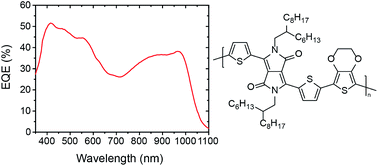EDOT–diketopyrrolopyrrole copolymers for polymer solar cells†
Abstract
The photovoltaic properties of a series of diketopyrrolo[3,4-c]pyrrole (DPP) copolymers containing 3,4-ethylenedioxythiophene (EDOT) as a comonomer are reported. With use of different aryl flanking units on the DPP core, namely thiophene, pyridine or phenyl, optical gaps ranging from 1.91 eV to 1.13 eV are achieved. When blended with the fullerene derivative [6,6]-phenyl C71-butyric acid methyl ester (PC71BM), the thiophene-flanked copolymer PDPP[T]2-EDOT with an optical gap of 1.13 eV was found to have the best photovoltaic performance, with an efficiency of 2.5% in an inverted device architecture. Despite having the lowest open circuit voltage of the three polymers studied, PDPP[T]2-EDOT-based devices were able to achieve superior efficiencies due to the high short circuit current of up to ∼15 mA cm−2. PDPP[T]2-EDOT-based devices also exhibit higher external quantum efficiencies which are associated with a superior microstructure – as revealed by transmission electron microscopy (TEM) and grazing incidence wide-angle X-ray scattering (GIWAXS) – which is associated with the enhanced aggregation tendency of PDPP[T]2-EDOT chains. In particular PDPP[T]2-EDOT : PC71BM blends were found to have a finer phase separated morphology with superior thin-film crystallinity. Surface morphology was also investigated with atomic force microscopy and near-edge X-ray absorption fine-structure spectroscopy.


 Please wait while we load your content...
Please wait while we load your content...